- History
- Pottery
- Industry
Stoneware
Stoneware is a ceramic fired at a high temperature, which fuses the body so that it is non-porous. While a glaze is not necessary, some stonewares have a glaze for technical, practical, or aesthetic reasons. In the second half of the 18th century Staffordshire potters developed a range of unglazed stonewares which were suited to the fashionable neo-classical style. Spode joined his fellow potters in making wares for this market.
Black Basalt | ||
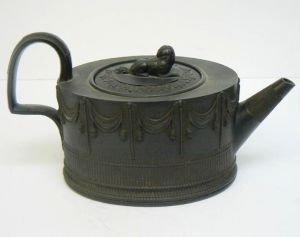 Teapot, impressed "SPODE" made 1790-1800 Norfolk Museums Service | John and Thomas Wedgwood, uncles of the more famous Josiah, first produced the fine-grained black stoneware called basalt in the 1750s. From the 1770s, an interest in the arts of antiquity prompted Staffordshire potters to take inspiration from the pottery of classical Greece and Rome. New styles of decoration included precisely turned fluting and applied designs of classical figures. A stylish product, basalt remained in popular into the
| 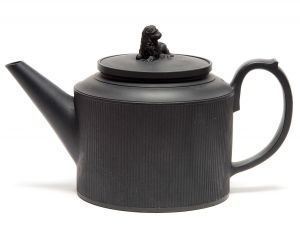 Teapot impressed SPODE, made about 1800 The Potteries Museum & Art Gallery, Stoke-on-Trent |
Cane Ware | ||
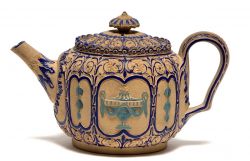 Teapot, impressed "SPODE 5" about 1785-90 The Potteries Museum & Art Gallery, Stoke-on-Trent | Staffordshire potters produced stoneware from local yellow clays that fired to a range of shades--from buff to a pale yellow-brown--that resembled cane or bamboo. Introduced in the 1770s, potters took advantage of its color and finish, decorating it with classical themes. Potters could leave exteriors unglazed, but occasionally painted them with enamel colors. Along with other potters, Spode made a range or decorative tea and ornamental wares to supply his fashioable customers. | 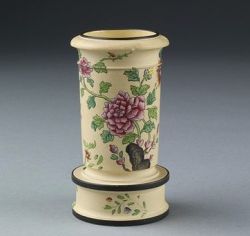 Spill vase impressed SPODE, painted pattern number 3405 in red, Spill vase impressed SPODE, painted pattern number 3405 in red, about 1805-10 © Victoria & Albert Museum, London |
Jasper | ||
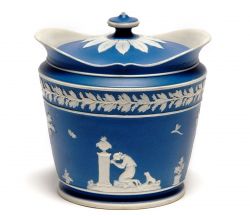 Sugar, impressed "Spode"about 1800-1810The Potteries Museum & Art Gallery, Stoke-on-Trent | Named for the hard mineral, Jasper is a very glassy, very dense stoneware - almost, but not quite, porcelain. After hundreds of experiments, Josiah Wedgwood perfected jasper for production of plaques and medallions in about 1774, with larger vases and decorative items possible after about 1780. Other potters, including Spode, were soon making similar wares . Jasper's popularity and production continue into the 21st century.
| 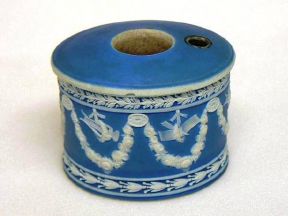 Inkwell, impressed SPODE about 1800 Norfolk Museums Service |
Smear-glazed Stoneware | ||
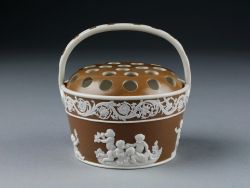 Flower basket, impressed "SPODE" about 1820 © Victoria & Albert Museum, London | In the early 19th century potters devised a new glazing technique. By coating stoneware with a "smear" of glaze so thin it did not obscure surface decoration, they were able to produce wares with ornate relief designs that remained sharp while reflecting a soft, attractive sheen. Neo-classical ornament remained a popular style, but producers supplemented it with a range of English hunting scenes. Spode was one of the foremost manufacturers. | 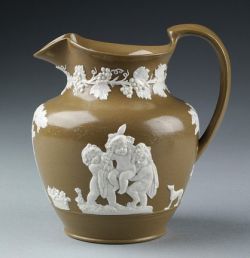 Jug impressed SPODE about 1820 © Victoria & Albert Museum, London |


